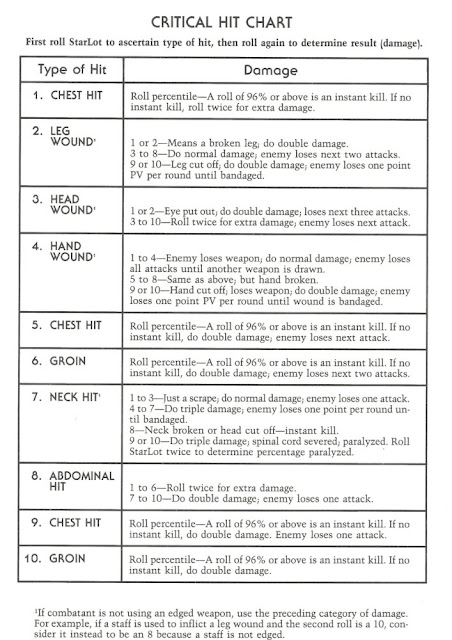 |
| Art by Liz Danforth |
The most recent iteration of Tunnels & Trolls– the Kickstarter funded “Deluxe” edition (dT&T) – was made available to backers scant days ago. Evidently, “several folks have pointed out a few corrections that need to be made” and last minute edits are being applied. Your humble host noticed something that may or may not be addressed.
In T&T– as in several other games – attribute scores are determined by rolling 3d6 and finding the sum. However, T&T adopts a “TARO” mechanic: triples add and roll over. If the 3d6 roll generates triples, the dice are rolled again and added to the triple result. If the second roll is triples, the process repeats and can do so ad infinitum. (I guess, technically, it should be “triples roll over and add” because there's nothing to add until the dice are rolled again.)
Anyway, a character with a triple-enhanced attribute is known as a “specialist,” discussed in Section 3.34 (page 18). A sidebar discusses the probability of triples:
For the curious, there is a 1 in 36 chance of triples happening for any given attribute – less than 3%. Although you get eight opportunities – once for each attribute – the overall odds remain 1 in 36 because each roll of the dice is independent of the previous rolls.If the word “overall” is removed, the statement is indisputably true. For any given attribute, the chance of rolling triples is 1-in-36 (i.e., 2.77% rounded). Since each attribute roll of 3d6 is an independent event, the odds do not change; the chance remains 1-in-36. However, the use of “overall” in connection with “eight opportunities,” implies that the chance of a character having a 'triple' result for any of eight attributes is 1-in-36. This implication is not true.
Welcome to the thrilling world of conditional probability. The graphic below attempts to show the probabilities associated with obtaining exactly one set of triples when rolling for eight attributes. Of course, it's possible to roll more than one set of triples when generating a character, but for the sake of demonstration let's look at just one 'branch' of the probability tree. The roll for the first attribute is either triples or it isn't. Regardless, the chance of the roll for second attribute being triples is still 1-in-36. Within the 97.23% probability of the roll for the first attribute not being triples, there is a 2.70% chance (i.e., 0.9723 ÷ 36) of the roll for second attribute being triples. Thus, there is a 5.47% chance (i.e., 2.77 + 2.70) that exactly one of the first two attributes will have a 'triples' result. By continuing this process, we discover there is a 79.83% chance that – for a course of eight attribute rolls – none of the rolls will be triples. Looking at it another way, an average of one-in-five T&T characters will be a specialist.
Of course, just because triples are rolled for a given attribute doesn't mean that the final value will be exceptionally high (or even better than average). A 'triple' roll could result in a final value as low as 7.
Section 12 of the dT&T rules is titled “Elaborations” and described as “Rule expansions, alternate ideas and additional suggestions...” We are told that “basic specialists are more about 'flavor' of background and role-playing than about special abilities.” In Section 12, however, specialists are presented as a distinct character type. ('Type' is the T&T equivalent of class.) If a character is to be a specialist type:
The player will...invent the character's special qualities related to the unusual attribute...Ideally this will be done with the cooperation and consent of...[the] Game Master to maintain overall balance with other players in the group.An example type is presented for each primary attribute. They typically call for doubling the dice total when making a saving throw with the specialized attribute in certain circumstances; however, players are encouraged to be inventive when establishing specialist abilities. Although designed for T&T, there's no reason the concept can't be applied to other games with attributes determined by 3d6. Here are some examples:
- Strength– The sample strength specialist is called a strong one. A strong one could be a character “whose spirit is strong in a way that translates into the ability to exert force in times of need.”
- Constitution– Sensitives have “one or more of their physical senses developed to an unusual degree.”
- Dexterity– Examples of dexterity specialists include rangers, acrobats, craftsmen, and athletes. In T&T terms, rangers are characters that have “an uncanny skill with ranged weapons.”
- Speed– Although a martial artist specialist can be based on other attributes, the rules discuss the possibilities of a speed specialist martial artist. Some examples speed-based martial art “styles” include “disabling moves and takedowns,” “Evading or redirecting an opponent's strikes,” or “catch[ing] missile weapons in flight, or bat[ting] them aside.”
- Intelligence– A mastermind specialist “has a better memory, a nimble wit, a swift insight into the implications of minor details, and a greater ability to solve problems.”
- Wizardry– “There are many different types of specialist magic-users possible: healer, combat mage, cosmic controller, and others.” Although specialist magic-users cannot understand magic beyond their specialty, they need not be taught the spells of their specialty. “When their abilities reach the point where they can learn a spell..., it unfolds in their mind like a flower.”
- Luck– The sample luck specialist is called a gambler. When making a saving throw regarding a calculated risk, a gambler doubles the dice result.
- Charisma– Leaders“take charge of situations and groups...In game terms, charisma saving throws often determine a character's success leading others.”













































